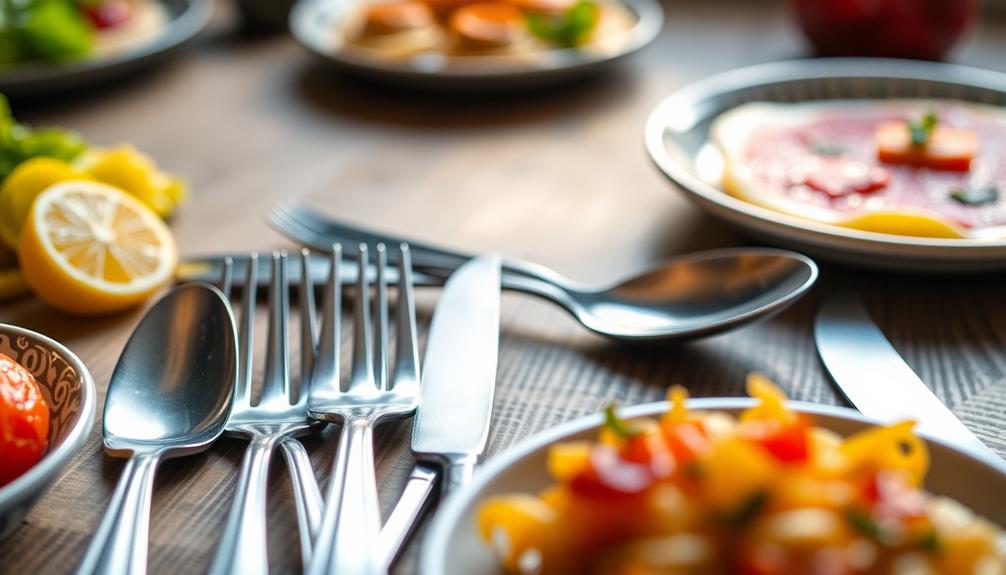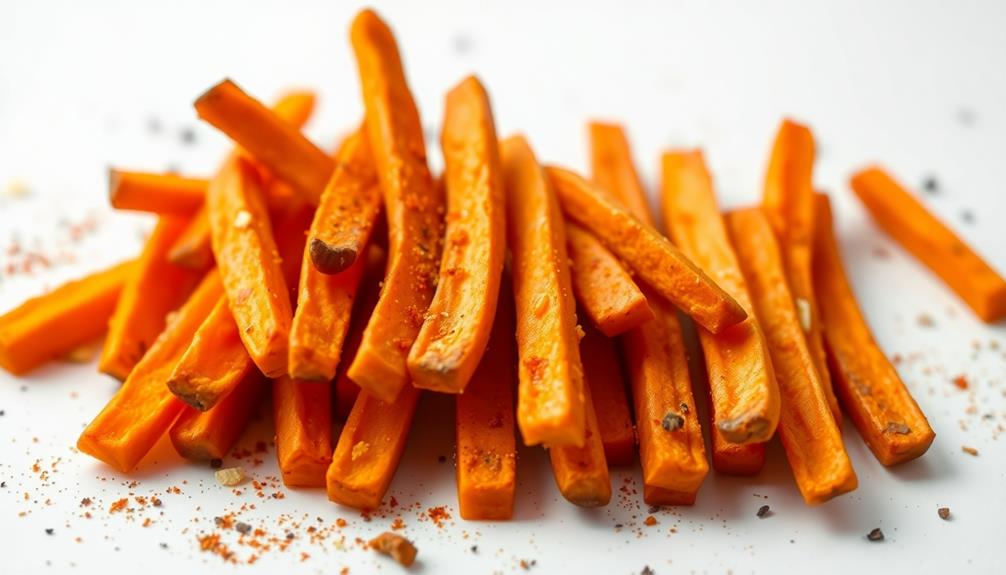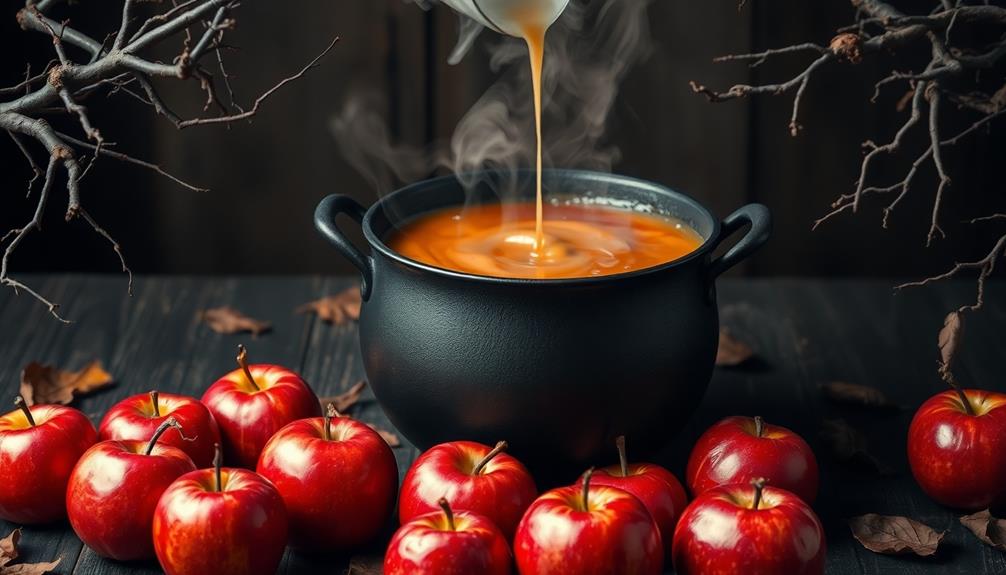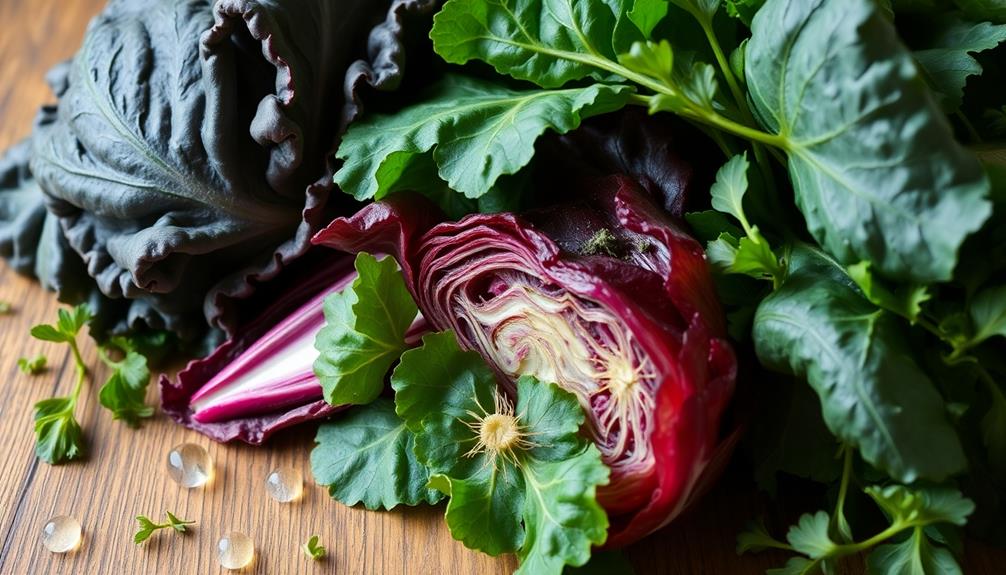The shape of your utensils greatly influences how you perceive flavors, often in subtle ways. For instance, deeper spoons can hold more liquid, intensifying taste experiences, while wider bowls help distribute flavors more evenly. You might notice that the weight of a utensil affects your enjoyment; heavier utensils often feel more luxurious, increasing satisfaction. Additionally, the visual appeal of your utensils also sets expectations for taste. Understanding these factors can enhance your overall dining experience and lead to surprising discoveries about your food. There's much more to uncover about how the dining environment affects your taste.
Key Takeaways
- The shape of utensils affects liquid capacity, influencing the intensity of flavors experienced during meals.
- Deeper spoons can hold more liquid, altering the taste experience by delivering more flavor at once.
- Wider bowls distribute flavors evenly across dishes, enhancing overall taste perception compared to narrow shapes that concentrate flavors.
- Utensil shape impacts the tactile experience, which can amplify or dampen flavor enjoyment during dining.
- The design of cutlery can shape initial flavor expectations, with elegant forms often leading to higher perceived meal quality.
The Role of Material
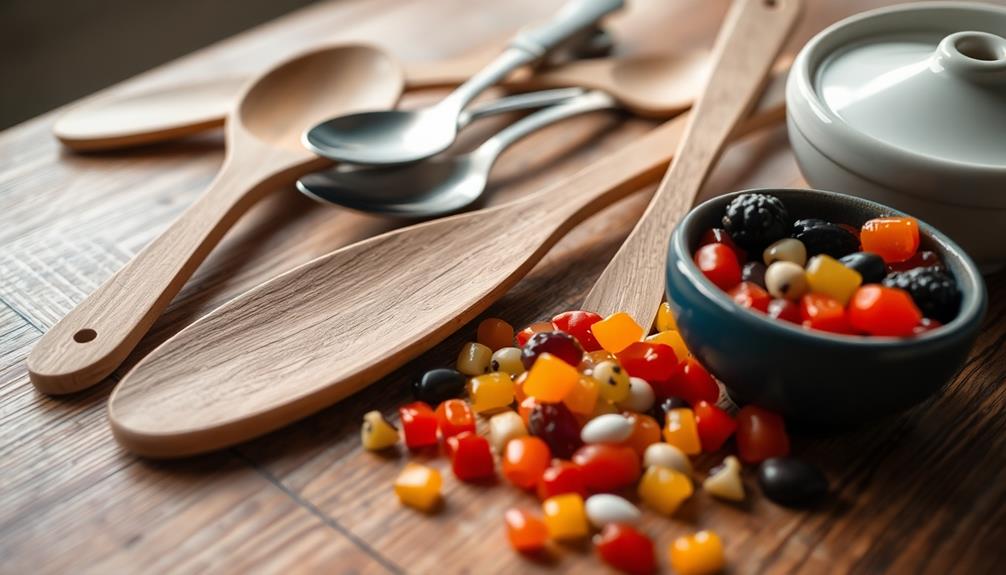
The material of your cutlery plays an essential role in how you perceive the flavors of your food. Studies show that stainless steel utensils are among the best choices for minimizing unwanted tastes. Unlike lower-quality metals or plastic, stainless steel doesn't alter the flavor profile of your meals. This is particularly important when enjoying rich dishes like Red-Braised Pork Belly, which rely on the delicate balance of flavors.
On the other hand, using zinc or copper spoons can amplify bitterness and metallic tastes, which mightn't be what you want when enjoying a delicate dish.
Interestingly, the weight of your cutlery can also affect your overall dining experience. Participants in research rated food served with heavier metallic spoons as more pleasant and higher quality. This suggests that both the material and weight of your utensils can enhance your enjoyment of food.
Conversely, light plastic spoons may lead you to perceive food as denser and more expensive, which can skew your flavor perception in dishes like yogurt.
Color and Its Effects
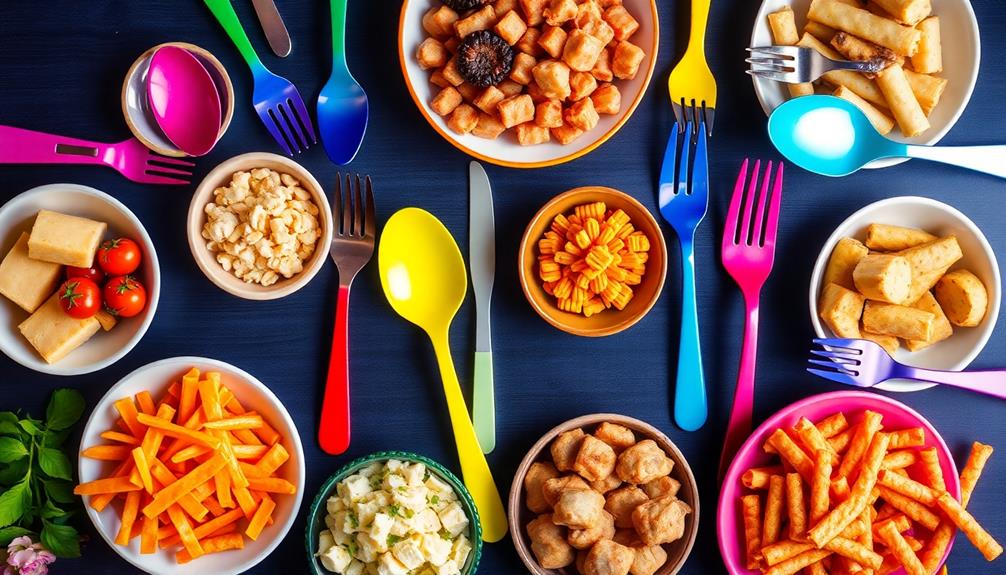
You might be surprised at how color affects your taste experience, from the contrast between your food and utensils to the emotional responses colors evoke.
The appearance of comfort foods, like a loaded baked potato, can be enhanced by the colors of the plates or utensils used, influencing not only how the dish looks but also how it tastes.
For instance, a white spoon can make yogurt taste sweeter, while a black one might do the opposite.
As you explore different color combinations, you'll notice how they can greatly shift your perception of flavor.
Color Contrast Effects
When it comes to enjoying a meal, color contrast between food and utensils plays an essential role in how flavors are perceived. Research shows that the hue of your cutlery can greatly impact flavor perception. For instance, white yogurt served with a white spoon is often rated as sweeter than when served with a contrasting color spoon. Similarly, using black spoons can diminish the perceived sweetness of sweet foods.
Here's a quick overview of how color contrast can influence your dining experience:
| Cutlery Color | Food Type | Effect on Flavor Perception |
|---|---|---|
| White | Sweet Yogurt | Sweeter |
| Black | Sweet Yogurt | Less Sweet |
| Contrasting | Any Food | Enhances Flavor Experience |
These findings indicate that the visual context set by color combinations can alter your expectations and enhance the flavor experience. So next time you set the table, remember that the color contrast between your food and cutlery can make a difference in how you perceive flavors. It's not just about what you eat, but how it looks!
Emotional Responses to Color
Colors have a powerful influence on our emotions and can greatly shape our dining experience. The way you perceive flavors can be markedly impacted by the colors surrounding your food. For instance, a dish like Dorayaki might look even more delightful when presented on a vibrant plate, enhancing its appeal.
When you consider the following aspects of color, you can enhance your meal:
- Red: This color often increases appetite and makes food look more appealing, which can elevate your overall enjoyment.
- Blue: In contrast, blue tends to reduce appetite, making food less enticing. You might notice that your craving for snacks diminishes in a blue-themed setting.
- Yellow: This cheerful color is linked to happiness, enhancing the vibrancy of your food's presentation and evoking positive emotional responses.
Additionally, color contrast plays an essential role in flavor perception. For example, if you serve white yogurt on a white spoon, it may taste sweeter compared to when it's on a black spoon.
Your expectations are shaped by the visual context, and this can greatly influence how you rate the taste. Ultimately, being mindful of color can heighten your dining experience, proving that emotional responses to color are just as important as the food itself.
Color Combinations Impact Taste
Experiencing a meal isn't just about the food itself; the colors of the utensils you use can dramatically alter your perception of taste. Research shows that color combinations play an essential role in flavor perception. For instance, using cold-colored glass can enhance thirst-quenching ratings for beverages, making your drink feel more invigorating.
Similarly, serving a vibrant dish like Caruru on colorful plates can elevate its appeal and enhance the dining experience. On the other hand, contrasting colors between your utensils and food can change how salty or sweet your meal tastes. In one study, white yogurt served with a white spoon was rated sweeter than when paired with other colors.
Emotional responses to colors also influence your taste ratings. For example, red utensils can enhance the perceived flavor and appeal of your food, while blue utensils might dampen your appetite. This means that the way you set your table can create varied flavor expectations, impacting your overall enjoyment.
Next time you dine, think about the color combinations on your plate and in your hands. The right hues can elevate your meal, transforming your experience and altering your perception of flavor in surprising ways.
Shape and Size Importance
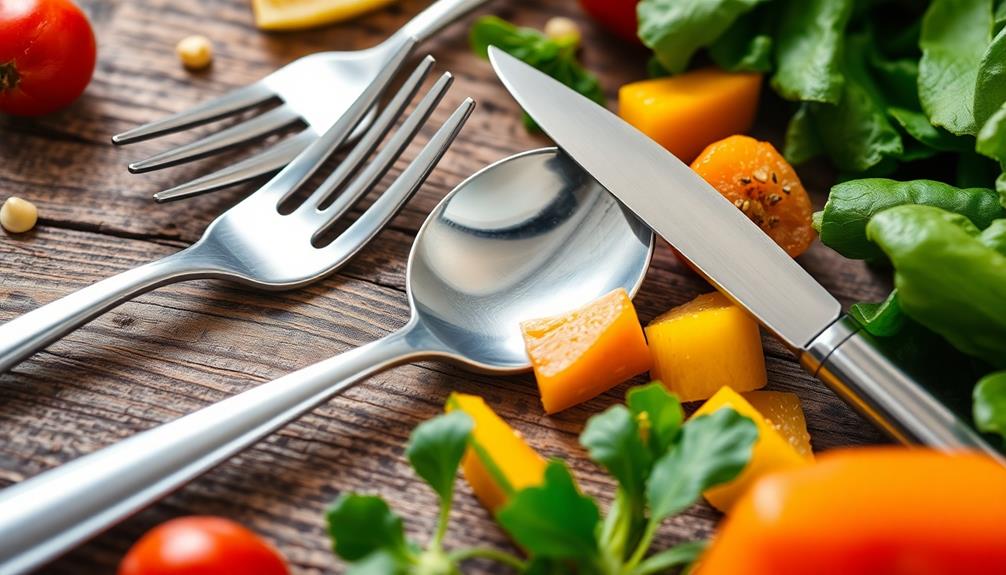
Utensil shape and size play an essential role in how you perceive flavor during meals. The design of your utensils can notably shift your flavor experience, making it vital to take into account both aspects when dining.
For instance, when enjoying traditional Greek dishes, the right utensils can amplify the experience of flavors like the rich aroma of Retsina or the satisfying crunch of Tomato Fritters.
Here are three key points to keep in mind:
- Spoon Shape: Deeper spoons hold more liquid, enhancing flavor intensity. Shallower spoons may not convey the same richness, altering your perception of taste.
- Plate Size: Larger plates often lead to larger portion sizes, impacting your sense of abundance and satisfaction. Smaller plates can help control your intake, enhancing your overall dining experience.
- Glassware Shape: The shape of your glass can affect aroma release. Wider glasses allow for better aroma diffusion, which can notably alter the flavor perception of your drinks.
Impact of Texture
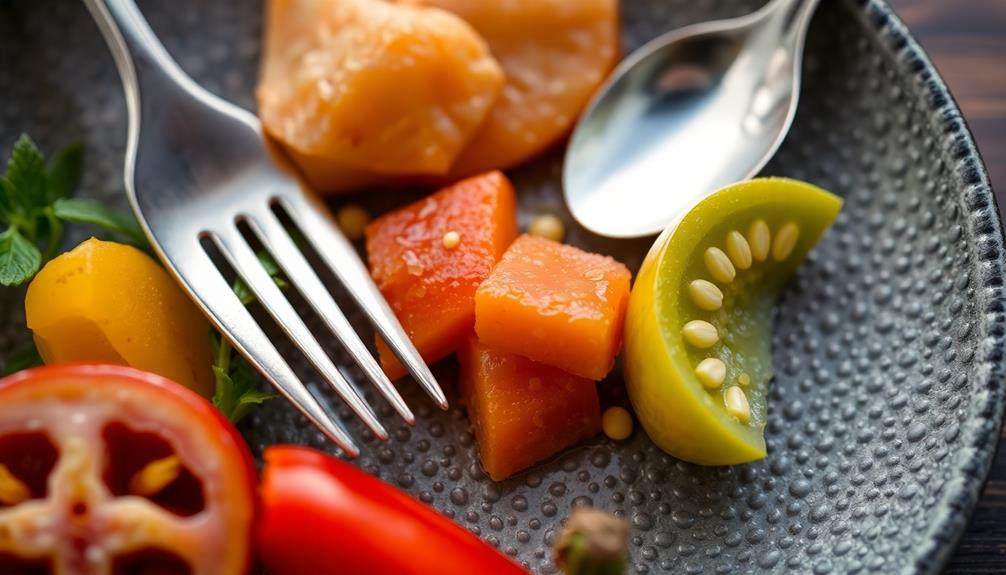
When you think about your dining experience, texture plays a vital role in how you perceive flavors.
For instance, the tactile sensation of enjoying traditional Ethiopian dishes like Yekolo (Roasted Barley) enhances the nutty flavor, making the experience more enjoyable.
From the roughness of clay bowls to the smoothness of glassware rims, each texture can enhance or alter your enjoyment of food and drink.
Texture's Role in Dining
Texture plays an essential role in how you perceive flavors during a meal. The way food feels in your mouth can greatly enhance or alter your overall dining experience. For instance, a dish like Nettle and Potato Soup can feel more comforting when served in a rough clay bowl, as the texture amplifies the creamy richness of the soup.
From the texture of your cutlery to the dishes you use, each element contributes to your perception of taste.
Here are three key aspects of texture's impact on dining:
- Bowl Material: Rough clay bowls create friction, amplifying taste sensations, whereas smooth porcelain can dull them.
- Utensil Texture: Metal spoons feel cool, impacting temperature perception and potentially altering taste. In contrast, wooden spoons offer a warmer, more comfortable feel.
- Glassware Rim: Smooth rims provide a pleasant drinking experience, while rough rims can heighten tactile sensations, affecting your enjoyment.
These textural differences in cutlery and dishware aren't just about aesthetics; they shape your expectations about flavor and quality.
The interplay of texture in dining not only enhances your enjoyment of the food but also plays an important role in flavor perception, guiding you through a multi-sensory experience. It's a subtle yet powerful factor that can change how you experience a meal.
Enhancing Flavor Through Texture
Although you mightn't realize it, the textures of the utensils and dishware you use can greatly enhance your flavor experience during a meal. For instance, the rough texture of a clay bowl creates friction that heightens your perception of flavors, making each bite more engaging.
In Indonesian cuisine, the use of natural materials like bamboo for serving dishes can add a unique element to the meal, as seen with Kue Putu, which is steamed in bamboo tubes. On the other hand, smooth utensils, like metal spoons, provide a cooler sensation, which can positively influence your enjoyment of the food.
When drinking, the texture of a glass rim also matters. A smooth rim offers a pleasant drinking experience, while a rough rim can intensify tactile sensations, sometimes overshadowing the drink's flavor.
Research shows that the texture of your utensils can change how you perceive flavors; for example, wooden spoons provide a warm, natural feel that may enhance certain foods' tastes.
In essence, the tactile experience of different textures in your tableware plays a significant role in your overall dining enjoyment. By selecting the right utensils and dishware, you can elevate your meal and savor the flavors in a whole new way.
Embrace the impact of texture—your taste buds will thank you!
Tactile Experience and Taste
How does the texture of your utensils influence your perception of taste? The tactile experience you get from your cutlery can dramatically impact how you perceive flavors.
For instance, a metal spoon's coolness might enhance the crispness of a chilled dessert, while a wooden spoon's warmth could make a hearty soup feel more comforting. The experience of enjoying a dish like Agnolotti can be heightened with the right utensils, as the texture of the pasta complements the flavors of the sauce.
Here are three key ways texture plays a role:
- Weight and Texture: Heavier cutlery often suggests better quality, raising your expectations for flavor intensity.
- Material Sensation: Rough clay bowls create friction, heightening flavor perception, whereas smooth porcelain might feel less engaging, dulling the sensory experience.
- Rim Texture: The edge of your glassware matters too; a smooth rim offers a sleek drinking experience, while a rough rim intensifies tactile sensations, making each sip feel more vibrant.
Ultimately, the interplay between texture and flavor perception shapes your overall dining experience. Different textures not only provide sensory engagement but can also alter the enjoyment of specific foods, making every meal a unique adventure.
Cutlery Properties Explored
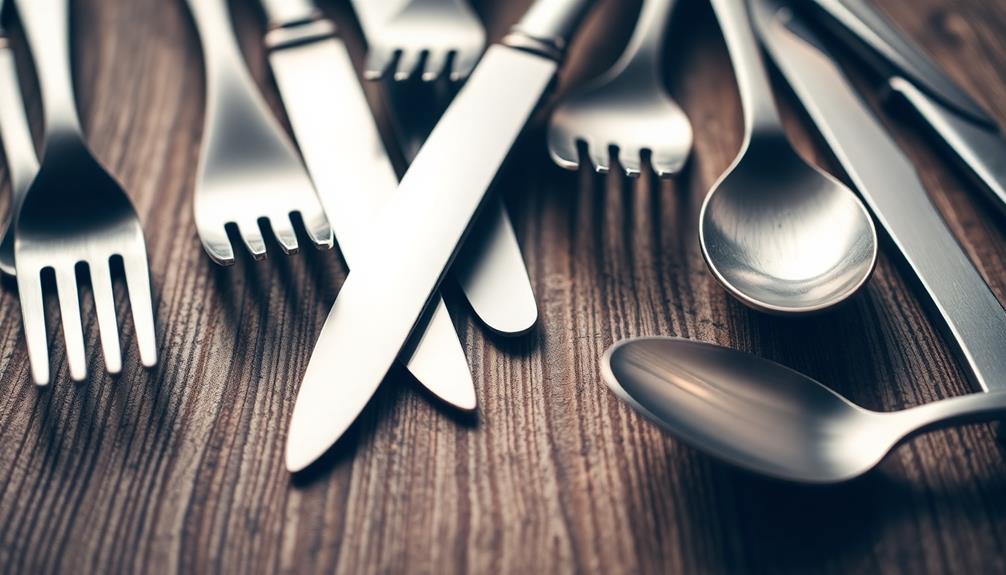
The interplay between cutlery properties and flavor perception reveals intriguing dimensions of our dining experiences. You mightn't realize it, but the shape of your cutlery can greatly influence how you perceive flavors.
For instance, deeper spoons hold more liquid, affecting the overall flavor experience, while wider bowls help distribute flavors evenly, leading to a different taste sensation. In Indian cuisine, the way you enjoy dishes like Mushroom Masala or Chicken Chettinad can significantly be affected by the type of utensils used.
On the other hand, narrower shapes can concentrate flavors, altering your perception even more. Studies show that when participants used different utensils, they rated the same food differently based on the cutlery's shape. Certain designs can enhance or diminish specific taste qualities, making a dish seem richer or more bland.
Additionally, the curvature of forks and spoons impacts the ease of food intake, which may change your sensory experience during meals.
Moreover, the visual appearance and shape of cutlery can shape your expectations about flavor, ultimately affecting your actual taste perception. These subtle cues, often overlooked, play a vital role in how you enjoy your meals, proving that cutlery isn't just functional; it's an integral part of our dining experience.
Experimental Findings Overview
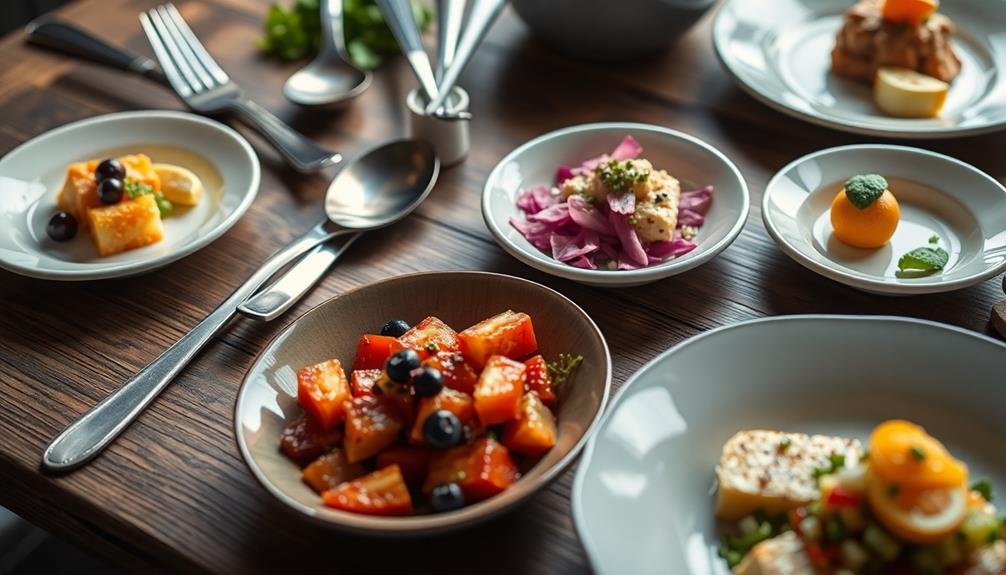
Experimental findings reveal that the shape of utensils plays an essential role in how you perceive flavor during meals. Studies highlight that different utensils can profoundly alter your dining experience, impacting everything from saltiness to sweetness.
- Utensil Shape Impact: Food tasted saltier when you used a knife compared to a fork, demonstrating how utensil shape can skew flavor perception.
- Spoon Size Matters: Smaller spoons enhance the perception of sweetness in desserts like yogurt, proving that even small changes can affect your taste experience.
- Bowl and Plate Dynamics: The shape of bowls and plates also influences flavor distribution. Wider bowls distribute flavors evenly, while deeper ones concentrate them, affecting how you enjoy your meal.
These findings suggest that the right utensil not only complements your meal but also enhances your overall enjoyment.
When you use utensils tailored for specific foods, you may find that your perception of flavor improves, adding a layer of satisfaction to your dining experience.
The relationship between utensil shape and flavor perception is an intriguing area of research that could change how you approach your next meal.
Sensation Transference Explained
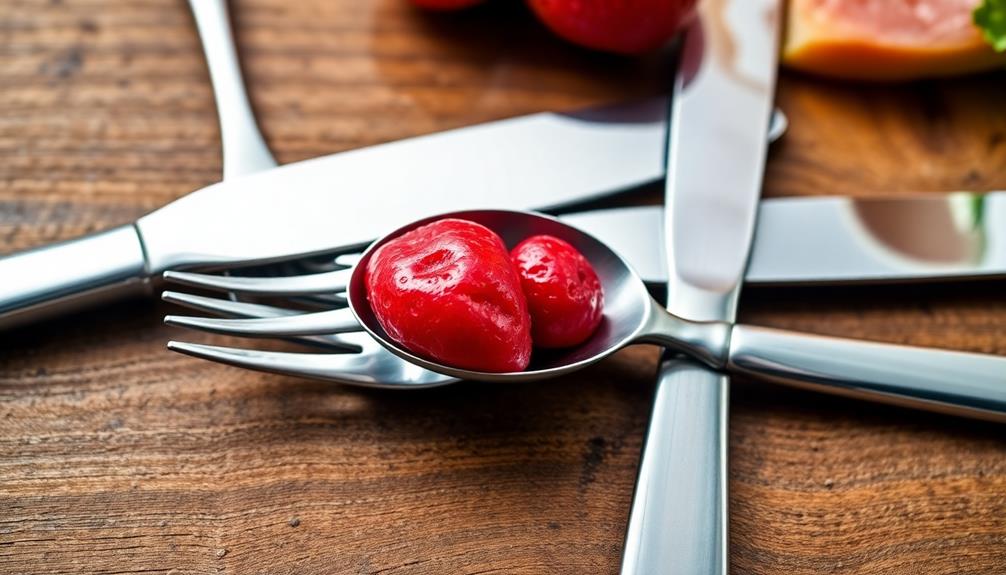
Sensation transference reveals a fascinating interplay between utensils and flavor perception. This phenomenon shows how the physical properties of cutlery—like weight and material—can greatly impact your enjoyment of food. For instance, you might find that heavier utensils evoke a sense of richness, leading to higher enjoyment ratings. Conversely, using lighter plastic spoons may lower your expectations of taste, making the food seem less appealing.
Interestingly, color also plays a role. Research indicates that yogurt can taste sweeter when sampled with white spoons, highlighting how visual associations influence your perception. The type of cutlery you use doesn't just affect how the food feels; it can alter the very essence of what you're tasting.
Before you even take a bite, the appearance and heft of your utensils shape your initial judgments. When you use lightweight cutlery, the food may feel less substantial, diminishing your overall experience.
Understanding sensation transference helps you appreciate how much your choice of cutlery influences flavor perception, turning an everyday meal into an extraordinary tasting experience.
Environmental Influences on Dining
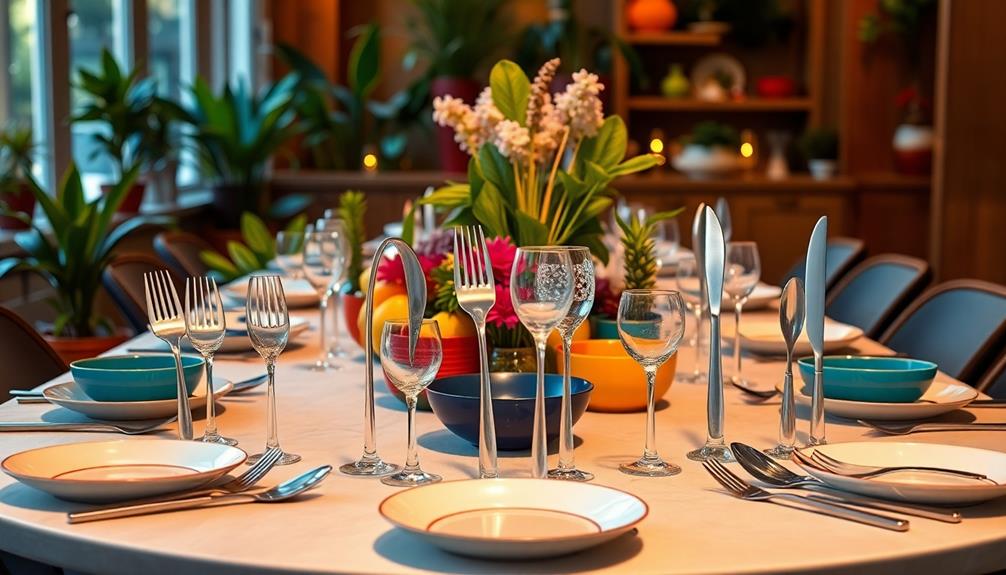
Many factors in your dining environment can dramatically shape your flavor perception and overall experience. Environmental factors such as lighting, ambiance, and social context play crucial roles in how you perceive flavors. It's not just about the food; it's about how everything around you influences your senses.
Here are three key elements to reflect upon:
- Lighting: Dim lighting can soften the appearance of food, making flavors seem richer, while harsh lighting may highlight imperfections, detracting from enjoyment.
- Tableware Aesthetics: The design and color of your utensils and plates can create expectations. For instance, contrasting colors can enhance flavor perception, making the meal seem more appealing.
- Social Context: Dining alone versus with others alters your sensory experience. Sharing a meal often enhances flavor, as good company can elevate your overall enjoyment.
Understanding these environmental factors helps you appreciate how context influences flavor perception.
Next time you sit down to eat, take a moment to reflect upon how your surroundings, from tableware aesthetics to ambiance, impact your culinary experience.
Frequently Asked Questions
How Do Utensils Affect Taste?
You'd think taste relies solely on ingredients, but surprise! Your spoon's depth might trick your brain into savoring flavors differently. Who knew that a tiny fork could turn your salad into a gourmet experience?
What Influences Our Perception of Flavor?
Your perception of flavor's influenced by various factors, including aroma, texture, temperature, and personal experiences. Each element interacts uniquely, shaping how you taste and enjoy food and beverages in everyday situations. For example, the aroma of a dish can evoke nostalgic memories, while the texture can play a role in the overall satisfaction of the eating experience. Additionally, the temperature of a beverage can significantly affect its perceived flavor, as some flavors are more pronounced at certain temperatures. Another crucial factor in flavor perception is how cooking vessel impacts flavor, as different materials and designs can impart unique characteristics to the final dish. Understanding these factors can help enhance the enjoyment of food and beverages in everyday life.
How Does the Shape of Food Affect Taste?
When you consider how shape affects taste, you'll notice that wider dishes enhance flavor distribution, unique designs elevate freshness perceptions, and textured foods engage your senses, all contributing to a more enjoyable eating experience.
What Are the Factors Affecting Taste Perception?
Taste perception's influenced by several factors, including aroma, texture, temperature, and even visual presentation. Your mood and past experiences also play a role, shaping how you enjoy and interpret flavors during each meal.
Conclusion
To sum up, you've discovered how the subtle shapes and surfaces of your utensils can greatly shape your dining experience. By embracing the artful alignment of material and design, you can elevate every bite. So, next time you sit down for a meal, remember the powerful interplay between your cutlery and flavor perception. This hidden harmony of utensils and tastes could turn an ordinary dinner into a delightful dining discovery. Savor not just the food, but the full experience!
